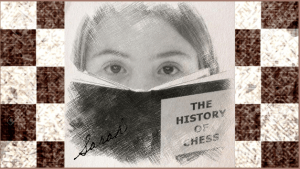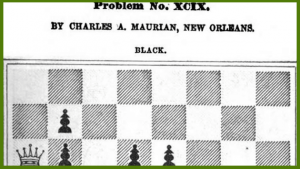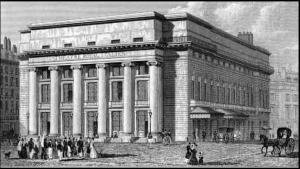
CAÏSSA'S BATTLEFIELD
CAÏSSA'S BATTLEFIELD Chess at its purest is a totally abstract game that requires nothing but one's mind. While the accoutrements of the game are unnecessary, th...

CAÏSSA'S BATTLEFIELD Chess at its purest is a totally abstract game that requires nothing but one's mind. While the accoutrements of the game are unnecessary, th...

In August of 1974 Richard Milhous Nixon became the first and only U.S. president to resign from office. But during his presidency - May 22 -30, 1972 - he made a historic trip to the Soviet Union. The History Channel s...

One of the oddest, yet intriguing variations in the King's Gambit Accepted is one discovered by Louis Eisenberg. Louis R. Eisenberg ...

Charles de Maurian, well known as Paul Morphy's childhood and life-long friend, developed very quickly as a chess player. He began learning the game from Morphy during the 1853-4 school year at Spring Hill College ...

Mt. Whitney, the hightest peak in the contiguous United States Nestled within the Sierra Nevada Mountains at the base of the highest peak in the lower 48 states, the high desert community of Lone Pine became the unl...

Many naturally talented chess players effortlessly envision mating patterns, applying them or threatening their application with amazing ease. Other, less talented players such as myself, must keep hammering t...

In 1945, right after WWII ended, a team of United States players competed against a team of Soviet players in a chess match via radio. While the U.S. team expected stiff competition, there was little doubt in...

As in attics where things once used get stored out of sight and mind, old articles have a way of burying themselves under the weight of those that follow becoming lost and forgotten. Sometimes it pays to put on an apron and gloves, wal...

Convergences: Miles of String by Marcel Duchampfrom the "First Papers of Surrealism" exhibition New York 1942, for the benefit of the French war relief societiesPhoto by John Schiff hangs at the Philadelphia Museum of Art. Untitled scul...

Mrs. Morphy is renowned in the salons of New Orleans as a brilliant pianiste and musician; and her son, without ever having studied music, has a similar aptitude for it, and he believes he would have become as famous therein as in chess, had he ...

About a decade ago, WilhelmThe2nd, from Chessgames.com sent me this article by Fedor Bohatirchuk about his personal memories of Efim Bogoljubov. The article, which had no accompanying pictures, is g...

In 1826 Johann Mälzel was amazing and mystifying the American public with his exhibition of the chess automation known as the Turk. Just a few years later, that same public would marvel at a living, sometimes chess-...

Most chess enthusiasts are aware that the young Wilhelm Steinitz was sometimes referred to as "the Austrian Morphy." Some might even know that Cecil de Vere had been called "the English Morphy." Few, ho...

Throughout the years there have been hundreds, maybe thousands, of brilliancy prizes offered. Some are just games, albeit extremely clever ones, while others have their own stories. Some even have stories that hove...

Avenida de las Palmeras, Habana, ca. 1904 A large island in the Caribbean, this former Spanish colony lies just 93 miles from the state of Florida. Its proximity to the United States, the inherent beauty of the...

Francis Eugene Brenzinger has been mostly forgotten. It's true that he wasn't even close to being a world champion contender, maybe not even a likely U.S. champion, but during his chess-playing days, he was...

Below are some of the images - photos, paintings, sketches, etchings - of Paul Morphy. Here is the earliest known image of Morphy - from 1854: from "Twice Remembered: Moments in the History of Spring Hill College" by Michael Kenny, S.J. ...

Edward Lasker published his delightful book "Chess of Fun & Chess for Blood" in 1942. In this book he examined Chess from the different perspectives of various amateurs in juxtaposition to that of serious tourn...

A Little Background: A man named Wolfgang von Kempelen created a supposed chess-playing machine in 1770. A chess master cleverly concealed inside controlled the exposed turbaned, mustached figure and the moves...

The January 1962 issue of "Chess Review" featured an article written by John Frederick Harbeson. The article was a reprint of one that had appeared in "The Germantowne Crier." The author was a prominent Philade...

The following is a reprint of a charming article composed by Al Horowitz in "Chess Review," Nov. 1953. Of course, this version has been updated to Algebraic Notation with the digital supplanting the physical. Al Horow...

The Cunningham Defense in the King's Gambit Accepted begins 1. e4 e5 2. f4 exf4 3. Nf3 Be7. White moves the Bishop to give his King a place to go with 4. Bc4. If Black continues with the threatened 4... Bh4+ ...

If you peruse old issues of "Chess Review," you will probably encounter the name Catherine Nye. You will mostly likely notice one of these photos of the pretty 34 year old lady from Syracuse, N.Y. 1941 ...

Throughout the history of the game, chess has produced innumerable fascinating personalities. Some were stars, others played supporting roles. Many of them, at least from the hazy vantage point of my clouded ...